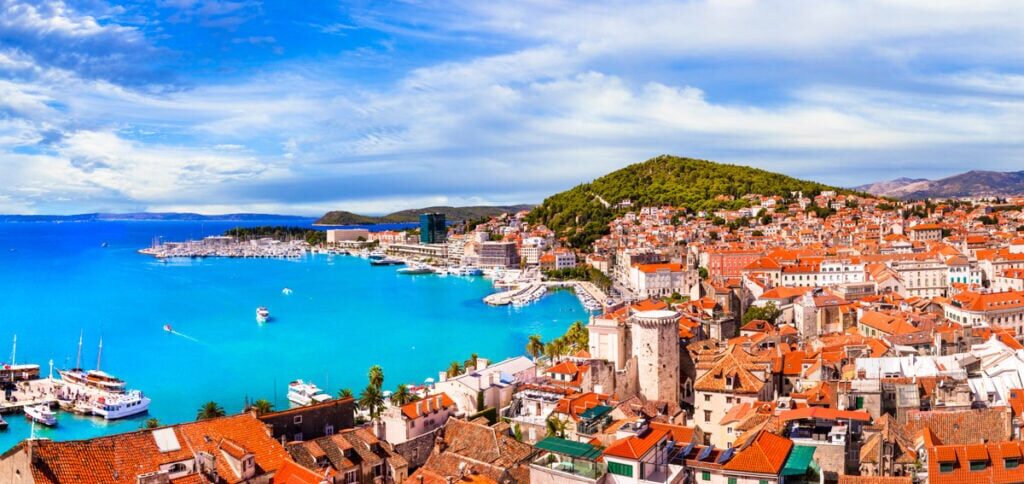When speaking about Croatia you are immediately reminded about the Roman past it had. With the entire of Croatia dipped in Roman history, there is one specific city that still retains its historic flavour.
Pula, a seafront city in Croatia’s Istrian Peninsula is well renowned for its protected harbour, beaches lined coast and of course the Roman ruins. Having its background in the prehistoric era, Pula has a strategic location, which enabled it to be captured, destroyed and rebuilt a number of times.
Pula was once administered by the Romans, the Ostrogoths, Venetians and even the Allied Forces during World War 2. The city of Pula is really small, with just 51.65 sq.km that has a population of a mere 57,460 people as of 2011 census. With a city this tiny, it will be easier for you to take a tour of it within a day or two.
So let us take a look at some of the best places to visit in Pula, Croatia
#1 The Roman Amphitheatre
As said above that Pula is still ruled by the Roman historic vibe, the Roman Amphitheatre is the first place to visit. At 133m long, 105m wide and 32m high, Pula’s oval Amphitheatre is the sixth-largest of its kind. This magnificent structure is a wonder in its own that has been crafted out of local limestone. Have you ever heard or seen a gladiator war in a book or a movie? If yes then this is the place which once hosted the same. This destination served the purpose of mass entertainment during its time when gladiatorial contests were held with a seating capacity of 20,000 people. If you happen to look closely, this structure was smartly built that consisted of a gutter on the top of the walls, which collected the rainwater while the slabs were used to secure the fabric canopy that protected the people from the sun rays. You can take a look at this massive structure from the outside but paying a certain entrance fee of 80 Kuna for adults and 40 Kuna for children will allow you to closely inspect from the inside. You will also be allowed to take a tour of the underground chambers where the wild beasts were kept while the dead gladiators were dragged away.

#2 Temple of Augustus
This massive temple has a high front porch that is supported by six Corinthian columns. It was built between 2 BC and 14 AD. It is known to survive the Christian era where it was converted into a Church that was torn down in 1944 by a bomb blast. This stone construction now houses a small archaeological display that is open to the public.

#3 Pula Aquarium
This is no regular aquarium as it is built in a 19th-century military fort, which was one of the 55 built to defend the Austro-Hungarian Empire’s main naval base. The artillery unit consists of sharks in this extraordinary aquarium that focuses on the theme of environmental issue. Other attractions in this aquarium comprise of rays, crabs, eels, starfish, anemones, seahorses, jellyfish, caimans, octopuses and a huge Indian python. This aquarium is also operating a sea turtle rescue Centre.

#4 Historical and Maritime Museum of Istria
Situated on the highest hill in Pula, at an elevation of 32 m, this museum now houses collections of national and universal heritage, right from the middle ages until the recent history. Divided into many sections, this museum has a Department of the history of Pula, Department of medieval Istrian history and the Department of modern Istrian history with collections such as a cultural-historic collection of urban life, a collection of old postcards and photographs, collection of maritime history and shipbuilding, collection of economic development, cultural-historical collection of suburban life, collection of insignia, diplomas, seals and coats-of-arms, coin collection, collection of arms, uniforms and military equipment, collection of film and video recordings, collection of memoirs and phonographic recordings, collection of significant persons and the recently established collection of old maps. From all these the collection of old postcards, maps, uniforms, arms and military and maritime equipment are worth having a look at.
#5 The Arch of Sergi
Built-in the 1st century BC, this 8m high arch was also known as the Golden Gate. It was built to commemorate the death of three Sergi brothers, namely, Lucius Sergi, Lucius Sergi Lipid and Gnaeus Sergi. This Triumphal Arch has a Corinthian style architecture with a significant influence of the Hellenic art of Asia Minor, which can be best seen on the decorative motifs. The gate and the walls were brought down during the 19th century during the urbanization period wherein the expansion of the town core was under planning.

#6 Lightning Giants
This is the best attraction in Pula so far and can only be enjoyed during the night time. An exclusive work of the art, the lightning giants are a unique modern installation, wherein the cranes of an old shipyard are lit up. This project is a brainchild of the world-famous designer Dean Skira, who also happens to be the owner of the Lumenart Company in Pula. The largest Croatian shipyard, Uljanik in Pula is home to this lightning art that have been installed with the help of the city of Pula, Ministry of Tourism, Arenaturist, Uljanik and others. With its conception in the year 2000, this project has been realized 14 years later on the 4th of May for the town’s day celebration and the final night of Visalia Festival. It is worth watching when the shipyard’s cranes are lit up in 16,000 different colour schemes for a period of 15 minutes.

#7 Partisan Memorial
Officially known as the ‘National Liberation Resistance Fighters & Fascist Terror Victims in Istria Memorial’, this monument was built to honour the many thousands of partisans and their supporters that were killed in Istria during the WWII. Behind the main sculptural piece are the bust of many prominent figures. Out of these, you need to look out for Ruža Petrovi? who can be identified as wearing a headscarf? In 1944 she was tortured by Italian fascists and had her eyes gouged out and soon after the war she founded by the society for the blind.
![]()
#8 Roman Floor Mosaic
The most intriguing part about Pula is its Roman history that happens to pop out of nowhere to remind the city of its bygone era. While the Roman historical pieces can be found in the most unusual places, one such place is hidden behind a car park on Flaciusova. Amidst the geometric motifs is a central panel showcasing a bad girl Dirce from Greek mythology being punished by being tied to the horns of a bull.
These are the best destinations to visit in Pula. So if you wish to know more or book a vacation, write to us on support@adventourist.in.







